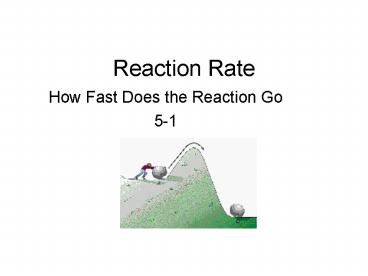Reaction Rate - PowerPoint PPT Presentation
1 / 31
Title: Reaction Rate
1
Reaction Rate
- How Fast Does the Reaction Go
- 5-1
2
Collision Theory
- Chemists believe that all chemical change
(rearrangement of matter) occurs due to the
collision of the atoms or molecules that are
reacting.
3
- Collisions must have enough energy to produce the
reaction (must equal or exceed the activation
energy). - Orientation of reactants must allow formation of
new bonds
4
For example 2BrNO(l) ? 2NO (g)
Br2 (g)
Molecules not correctly orientated, so no reaction
Molecules are correctly orientated, so reaction
occurs
5
Activation Energy - Minimum energy to make the
reaction happen Ea
Reactants
Energy
Products
Reaction coordinate
6
Activated Complex or Transition State
Reactants
Energy
Products
Reaction coordinate
7
Reactants
Energy
Overall energy change ?H
Products
Reaction coordinate
8
Endothermic Reactions
9
Exothermic Reactions
10
Things that affect Rate
- 1. Temperature
- -Higher temperature faster particles.
- -More and harder collisions.
- -Faster Reactions.
11
Temperature Reaction Rate
12
Things that affect rate
- 2. Concentration
- -More concentrated closer together the
molecules. - -Collide more often.
- -Faster reaction.
13
Things that Effect Rate
- 3. Nature of reactants
- a. Reactions are rapid at room temperature if
no bond rearrangement are required - Ionic reactions
- Pb2(aq) SO42-(aq) ? PbSO4(s)
14
- b. Reactions are slow at room temperature when
several bonds in the reacting substances must be
broken - Molecular reactions
- C2H5OH 3 O2 ? 2CO2 3H2O
15
- 4. Surface area
- -Molecules can only collide at the surface.
- Smaller particles bigger surface area.
- Smaller particles faster reaction.
16
- 5. a)Catalysts- substances that speed up a
reaction without being used up.(enzyme). - -Speeds up reaction by giving the reaction a
new path. - -The new path has a lower activation energy.
- -More molecules have this energy.
- -The reaction goes faster.
- b) Inhibitor- a substance that slows down a
reaction (raises the activation energy).
17
Endothermic Reaction witha Catalyst
18
Exothermic Reaction with a Catalyst
19
Catalysts Increase the Number of Effective
Collisions
20
Reaction Mechanism
- Elementary reaction- a reaction that happens in a
single step. - Reaction mechanism is a description of how the
reaction really happens. - It is a series of elementary reactions.
- The product of an elementary reaction is an
intermediate. - An intermediate is a product that immediately
gets used in the next reaction.
21
- This reaction takes place in three steps
22
Ea
- First step is fast
- Low activation energy
23
Ea
Second step is slow High activation energy
24
Ea
Third step is fast Low activation energy
25
Second step is rate determining
26
Intermediates are present
27
Activated Complexes or Transition States
28
Mechanisms and rates
- There is an activation energy for each elementary
step. - Slowest step (rate determining) must have the
highest activation energy.
29
A chemical example of a Reaction Mechanism
- H2 (g)I2 (g) ? 2HI (g)
- This reaction is very slow at room temperature
but if the system is exposed to sunlight ( source
of UV light ) the reaction proceeds rapidly.
30
- Step 1
- I2 (g) ?2I (g)
- Step 2
- H2 (g)2I (g) ? 2HI (g)
- Overall H2 (g)I2 (g) ? 2HI (g)
31
Mechanism with catalyst
- Step rate
- Cl O3 ? O2 ClO Medium
- O3 ? O2 O Fast
- ClO O ? Cl O2 Fast
- Overall 2O3 ? 3O2
- Intermediates are ClO and O catalyst is Cl































